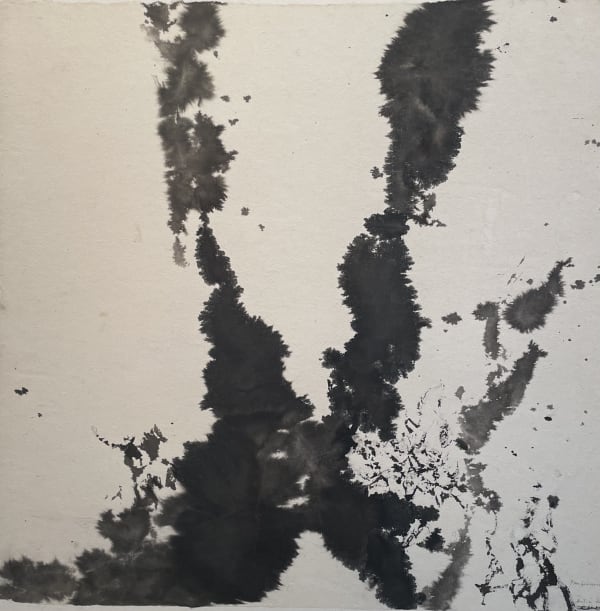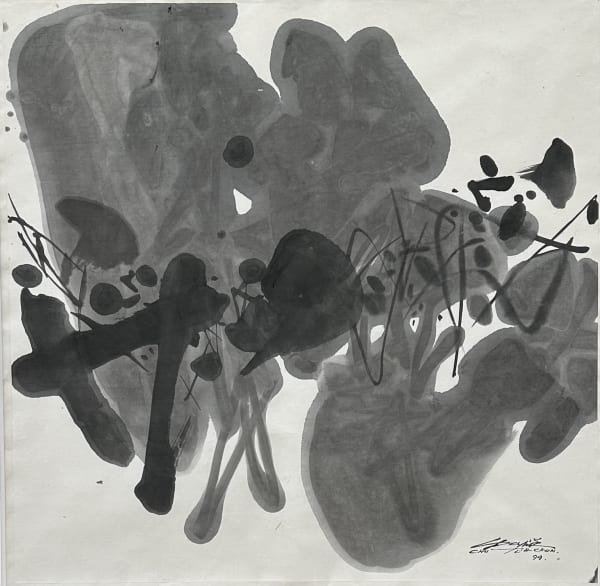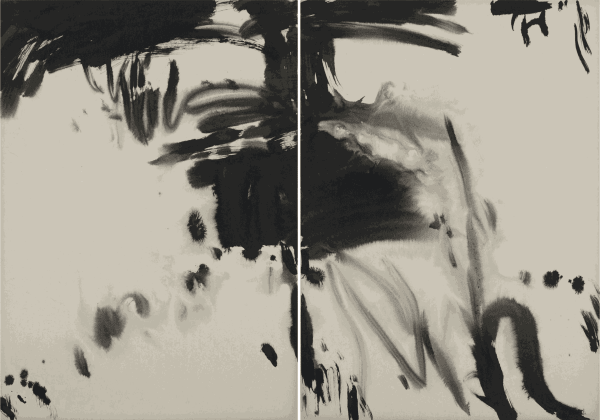‘I am looking for an art without constraints in which I can evolve freely,’
T'ang Haywen
T’ang Haywen and Zao Wou-Ki arrived in Paris at the same time in 1948. Chu Teh-Chun followed them in 1955. This trio of exiled artists found in the French capital the ideal conditions to practise their art freely, in opposition to the Cultural Revolution in China. When they arrived in Paris, the post-war world was in turmoil: people were talking about new realities, intuition and spontaneity. The principles of mechanisation and reason were being questioned. The climate of triumph for lyrical abstraction and abstract expressionism, both of which drew on Eastern calligraphy (without copying it), proved fertile ground for these creators, who were free to navigate between meaning and form, between calligraphy and painting. ‘I am looking for an art without constraints in which I can evolve freely,’ explained T’ang Haywen.
The painters exhibited here present three different approaches to Chinese ink in the 20th century, but always rooted between tradition and modernity.
Ink painting, a thousand-year-old art form and previously the preserve of the literati, nevertheless remains essential for 20th-century Chinese artists. This aesthetic of the sign, which transcends realism, narration and perspective and moves towards abstraction, also fascinated the Second School of Paris, with its lyrical abstraction. In the Chinese pictorial tradition, there is no opposition between abstraction and figuration. The three painters chosen here serve as examples, each with their own unique and individual approach to ink.
-
 Zao Wou-Ki, Sans titre, 1992, encre sur papier, 65 x 66 cm
Zao Wou-Ki, Sans titre, 1992, encre sur papier, 65 x 66 cm -
 T'ang Haywen, Sans titre, ca. 1969, ink and gouache on paper, 70 x 100 cm.
T'ang Haywen, Sans titre, ca. 1969, ink and gouache on paper, 70 x 100 cm. -
 T'ang Haywen, Sans titre, ca. 1969, ink and gouache on paper, 70 x 100 cm.
T'ang Haywen, Sans titre, ca. 1969, ink and gouache on paper, 70 x 100 cm. -
 Chu Teh-Chun, Sans Titre, 1999, ink on paper, 67,5 x 69,5 cm
Chu Teh-Chun, Sans Titre, 1999, ink on paper, 67,5 x 69,5 cm -
 Zao Wou-KI, Sans Titre, 1996, 42 x 32 cm, Encre de Chine sur papier
Zao Wou-KI, Sans Titre, 1996, 42 x 32 cm, Encre de Chine sur papier -
 Chu Teh-Chun, Sans Titre, 196, 54 x 35 cm, Aquarelle et gouache sur papier
Chu Teh-Chun, Sans Titre, 196, 54 x 35 cm, Aquarelle et gouache sur papier -
 T'ang Haywen, Sans Titre, ca. 1970, 70 x 100 cm, Diptyque, Encre sur papier fort Kyro
T'ang Haywen, Sans Titre, ca. 1970, 70 x 100 cm, Diptyque, Encre sur papier fort Kyro -
 T'ang Haywen, Sans Titre / Untitled | ca. 1970 | 70 x 100 cm | Diptyque / Diptych Encre sur papier fort Kyro
T'ang Haywen, Sans Titre / Untitled | ca. 1970 | 70 x 100 cm | Diptyque / Diptych Encre sur papier fort Kyro -
 T'ang Haywen, Sans Titre / Untitled | ca. 1970 | 70 x 100 cm | Diptyque / Diptych I Encre sur carton Kyro
T'ang Haywen, Sans Titre / Untitled | ca. 1970 | 70 x 100 cm | Diptyque / Diptych I Encre sur carton Kyro -
 T'ang Haywen, Sans Titre / Untitled | ca. 1972-3 | 70 x 100 cm | Diptyque / Diptych I Encre sur carton Kyro
T'ang Haywen, Sans Titre / Untitled | ca. 1972-3 | 70 x 100 cm | Diptyque / Diptych I Encre sur carton Kyro
This year, as part of its participation in the Printemps Asiatique at La Pagode from 5 to 12 June, the Galerie Jean-François Cazeau is showcasing the work of three 20th-century Chinese masters of ink painting: T'ang Haywen (1927-1991), Zao Wou-Ki (1920-2013) and Chu Teh-Chun (1920-2014). An exhibition dedicated to them will then be held at the gallery in the Marais district from 14 June to 19 July, continuing the comparison of this body of work by major artists.
T'ang Haywen and Zao Wou-Ki arrived in Paris at the same time in 1948. Chu Teh-Chun followed them in 1955. This trio of exiled artists found in the French capital the ideal conditions to practise their art freely, in opposition to the China of the Cultural Revolution. When they arrived in Paris, the post-war world was in turmoil: people were talking about new realities, intuition and spontaneity. The principles of mechanisation and reason were being questioned. The climate of triumph for lyrical abstraction and abstract expressionism, both drawing on the sources of Eastern calligraphy (without copying them), proved fertile ground for these creators, who were free to navigate between meaning and form, between calligraphy and painting. ‘I am looking for an art without constraints in which I can evolve freely,’ explained T'ang Haywen.
The painters exhibited here present three different approaches to Chinese ink in the 20th century, but always rooted between tradition and modernity.
Upon his arrival in Paris, Zao Wou-Ki, trained at the Academy of Fine Arts in Hangzhou, quickly became part of the dynamic of lyrical abstraction and befriended Henri Michaux, ‘painter of movements,’ Joan Miró and Pierre Soulages. Although he mainly painted in oil on canvas, ink remained central to his work. Despite his detachment from tradition, this technique is nevertheless an integral part of his universe.
T'ang Haywen arrived in Paris to study medicine, but quickly decided to become a painter. He began learning oil painting at the Académie de la Grande Chaumière, but soon realised that it was not for him. Thus, from the 1960s onwards, his work was mainly created in ink, in the great tradition of the eccentric masters of the Qing dynasty, notably through Shitao's Discourse on Painting. His style developed from calligraphy but, unencumbered by academicism, found complete freedom.
Chu Teh-Chun remains one of the leading proponents of a synthesis between Chinese tradition and Western modernity. His encounter with the work of Nicolas de Staël, which pushed him towards abstraction while retaining the imprint of the landscapes sketched in his native country, was a major turning point in his development.
The Galerie Jean-François Cazeau, located in the Marais district of Paris since 2009, builds bridges between the Modern Masters and post-war art on both sides of the Atlantic.












